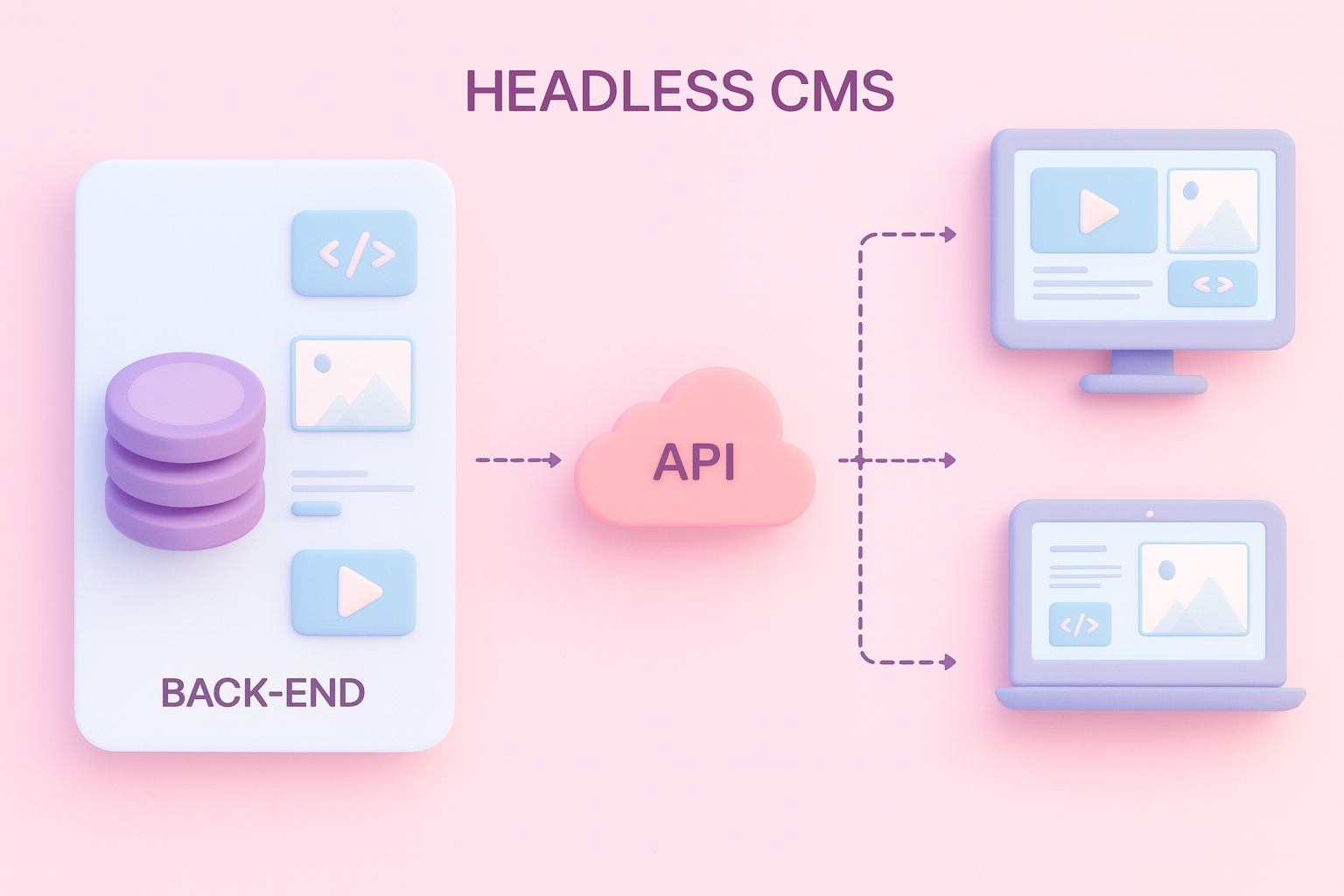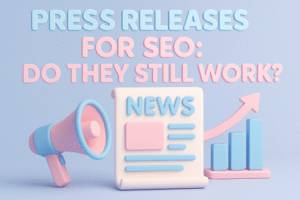If you’re on the hunt for a new CMS in 2025, chances are you’ve run into the term “headless CMS” more than once.
And for good reason: headless platforms have gone from niche developer tools to mainstream content hubs powering websites, apps, digital displays, even voice and AR experiences.
So what makes them different? Instead of locking your content inside a website template (like a traditional WordPress or Drupal setup), a headless CMS stores everything in a flexible, structured way and delivers it through APIs.
That means your content can live anywhere: your marketing site, your mobile app, even the smartwatch your customers just strapped on.
The big win? Freedom and future-proofing. You’re not tied to a single front end, and your developers can build with the latest frameworks while your marketers still get modern editing tools.
In other words, you get speed, flexibility, and the ability to actually reuse content across all the places you need it.
In this guide, we’ll walk through the top headless CMS options in 2025: who they’re best suited for, what makes them shine, and a few things to watch out for.
TL; DR – What This Article Covers
- A quick primer on what makes a CMS “headless”, and why organizations are making the leap.
- The top 2025 headless CMS platforms (from SaaS leaders to open-source trailblazers), highlighting their standout features and recent innovations.
- How to evaluate and compare headless CMS platforms using criteria like editing UX, performance, AI capabilities, and composability.
- Strategic guidance for teams looking to choose, implement, or migrate to a headless CMS setup.
Quick Snapshot: What’s Out There in 2025
Not all headless CMS platforms are built alike. Here’s a bird’s-eye view so you can quickly see where you might fit:
| Type | Best For | What You Get | Examples |
|---|---|---|---|
| Enterprise Headless CMS | Large teams that need governance, multi-language, personalization | Robust workflows, security, AI, integrations with CRM/CDP | Contentstack, Contentful, Kontent.ai |
| Headless CMS with Visual Editing Options | Marketing teams that want to see changes as they build | Drag-and-drop, real-time previews, slice/block editors | Storyblok, Builder.io, Prismic |
| Developer-Led / Self-Hosted Headless CMS | Dev-heavy orgs that want control, no vendor lock-in | Full code ownership, custom plugins, open-source flexibility | Strapi 5, Payload, Directus |
| GraphQL-First Headless CMS | Teams who want strong APIs and federation | Flexible GraphQL queries, schema stitching across data sources | Hygraph, DatoCMS |
| Budget-Friendly OSS | Small teams, side projects, static sites | Free, Git-based workflows, simple setup | Decap CMS |
How We Picked These Platforms (Our Approach)
There are dozens of headless CMS options on the market, but not all of them are equally mature or widely adopted.
For this guide, we reviewed the most established and fastest-growing platforms based on a mix of sources: recent product updates, industry momentum, and – importantly – real user feedback from sites like G2, Capterra, and TrustRadius.
We looked at how customers rate these tools for ease of use, editor experience, developer flexibility, and support.
The result is a balanced shortlist that covers the main categories: enterprise SaaS leaders, visual editing platforms, developer-led and open-source solutions, and GraphQL-first specialists.
Each headless CMS included here is not only active and evolving in 2025, but also has a track record of helping teams deliver real-world projects at scale.
Enterprise-Level Headless CMS Options
1. Contentful – Enterprise Composable Content
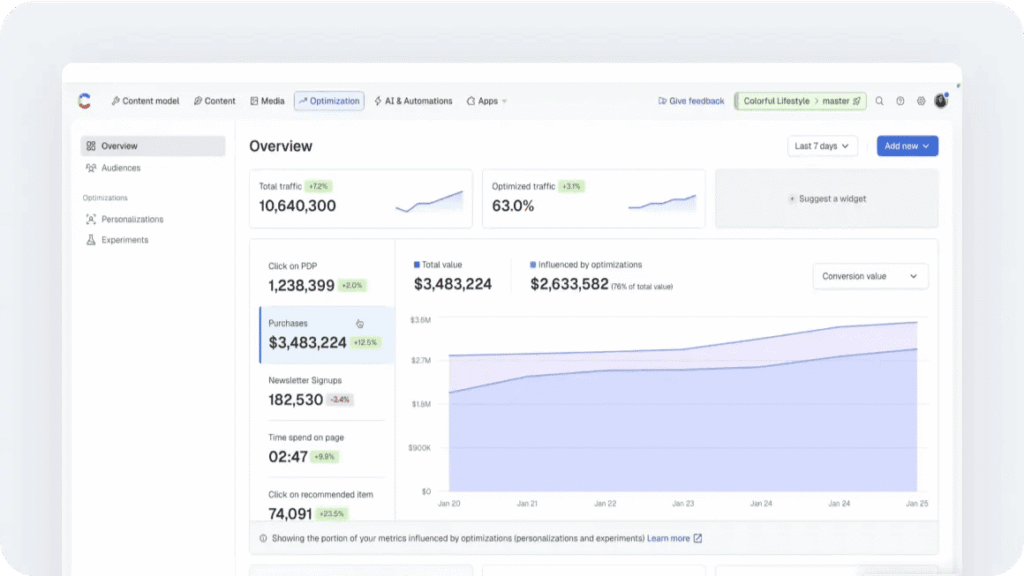
Contentful is one of the most widely adopted headless CMS platforms, positioned squarely in the enterprise SaaS category.
It markets itself as a “composable content platform,” enabling organizations to unify content across digital experiences while maintaining scalability, governance, and speed.
Best For
- Enterprises and mid-to-large organizations with distributed teams
- Businesses seeking strong governance, role-based workflows, and localization
- Companies that want to integrate a CMS into a broader composable DXP stack
Standout Features
- Contentful Studio (launched 2025): a low-code, visual workspace that allows marketers and product owners to build experiences without developer bottlenecks.
- AI-Driven Content Modeling & Authoring: AI assists in structuring, generating, and localizing content at scale.
- Extensive Ecosystem: Robust marketplace with prebuilt apps and integrations (e-commerce, analytics, DAM, CDP).
- Scalability: Designed to handle enterprise-level content operations across multiple channels, brands, and regions.
Recent Developments
- 2025 saw a push into personalization and orchestration, expanding Contentful’s role from CMS to part of the wider composable DXP landscape.
- Ongoing investment in AI features to accelerate content creation and reduce manual workload for editors.
Considerations
- Pricing can scale steeply as you add environments, locales, and users.
- While developer-friendly, smaller teams may find the enterprise orientation heavier than needed.
2. Contentstack – CMS Evolving into an Adaptive DXP
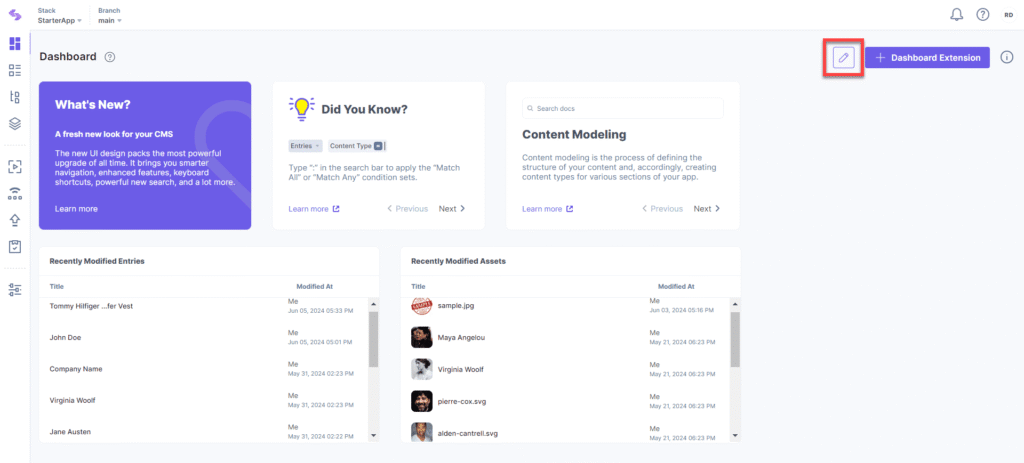
Contentstack has established itself as a leader in the enterprise SaaS headless CMS space, with a strong focus on enabling organizations to go beyond content management into full digital experience composition (DXP).
It differentiates itself with advanced workflows, enterprise governance, and a growing suite of integrated AI and personalization tools
Best For
- Enterprises prioritizing personalized, multi-channel experiences
- Organizations needing robust governance and workflow management
- Teams building a composable DXP with real-time data and orchestration
Standout Features
- EDGE DXP (2025 launch): A unified platform combining CMS, personalization, orchestration, and analytics for real-time digital experiences.
- Lytics CDP Integration (via 2025 acquisition): Deep audience segmentation and personalization capabilities are now natively available within the platform.
- Enterprise-Grade Workflows: Role-based governance, approval chains, and localization tools designed for global organizations.
- Composable Architecture: Strong integrations with commerce, analytics, DAM, and marketing automation platforms.
Recent Developments
- January 2025: Acquired Lytics, a customer data platform, expanding its personalization and data capabilities.
- February 2025: Introduced EDGE DXP, signaling a shift from pure CMS to a broader composable experience platform.
- Ongoing investment in AI-assisted authoring and content orchestration.
Considerations
- Positioned at the higher end of the market, cost and implementation effort reflect its enterprise focus.
- May be more complex than necessary for smaller or less digitally mature teams.
3. Kontent.ai – Enterprise Modular Content at Scale
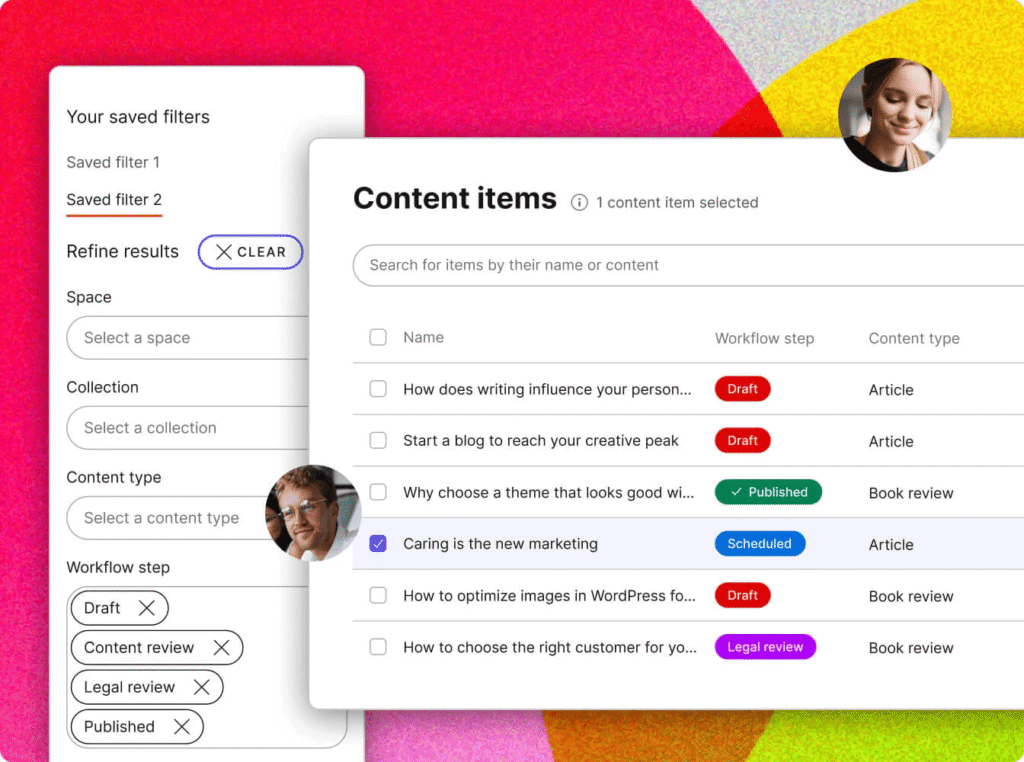
Kontent.ai is a modular content platform purpose-built for enterprises managing complex content operations at scale.
Spun out of Kentico, it has carved a space as a governance-focused, API-first CMS that balances enterprise needs for compliance and structure with modern delivery flexibility
Best For
- Large organizations managing multi-brand, multi-language content
- Teams needing strict governance, compliance, and auditability
- Enterprises seeking a reliable, API-first CMS with strong editorial tooling
Standout Features
- Structured Content Modeling: Flexible schema design for enterprise content needs, with strong localization and taxonomy management.
- Workflow & Governance: Advanced permissions, role-based approvals, and compliance-ready audit trails.
- API-First Delivery: REST and GraphQL APIs designed for performance across global deployments.
- Collaboration Tools: Editor-friendly interface with inline comments, real-time collaboration, and preview capabilities.
- Enterprise Integrations: Connectors for commerce, analytics, and DAM platforms.
Recent Developments
- Rebranded as Kontent.ai, reinforcing its positioning as an independent, AI-forward headless platform.
- Expanded AI features to assist with content generation, tagging, and localization.
- Continued investment in editor experience to make the platform more approachable for non-technical users while preserving enterprise-level control.
Considerations
- Squarely aimed at enterprise buyers, may feel overbuilt for mid-market organizations.
- Lacks the marketplace depth of Contentful, though integrations with common enterprise systems are strong.
Best CMS with Visual Editing
1. Storyblok – Headless with a True Visual Editor
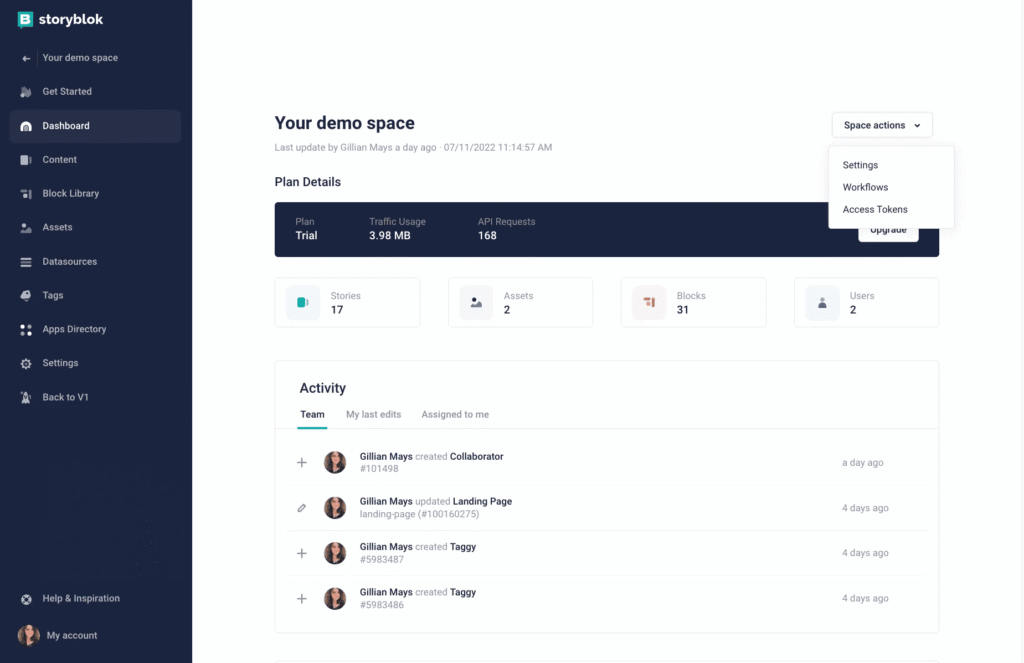
Storyblok is a leading visual editing headless CMS, designed to give marketers and content teams the ease of a page builder without sacrificing the flexibility of an API-first backend.
Its hallmark is the Visual Editor, which provides a live, on-page editing experience, making it one of the most approachable headless platforms for non-technical users.
Best For
- Marketing teams that want intuitive, what-you-see-is-what-you-get editing
- Businesses balancing developer flexibility with editor usability
- Organizations looking for a scalable SaaS CMS with strong localization support
Standout Features
- Visual Editor: Real-time, on-page editing with drag-and-drop blocks (called “components”).
- Component-Based Architecture: Developers create reusable content blocks; editors compose pages visually from those blocks.
- Multilingual Capabilities: Advanced localization tools for global content operations.
- Collaboration & Workflows: Roles, permissions, and approvals built for team environments.
- Marketplace & Integrations: Plugins for commerce, analytics, DAM, and other tools.
Recent Developments
- Expanded Visual Editor capabilities in 2024–2025, including richer previews and collaborative features.
- Growing emphasis on enterprise-readiness, with enhanced performance, governance, and integrations.
- Continued investment in the partner ecosystem, making Storyblok a strong choice for agencies and implementation partners.
Considerations
- While editor experience is excellent, developers may find it less customizable compared to schema-as-code systems like Sanity.
- SaaS pricing can climb with increased usage, especially for organizations managing multiple sites or locales.
2. Builder.io – Visual Development + Headless Content
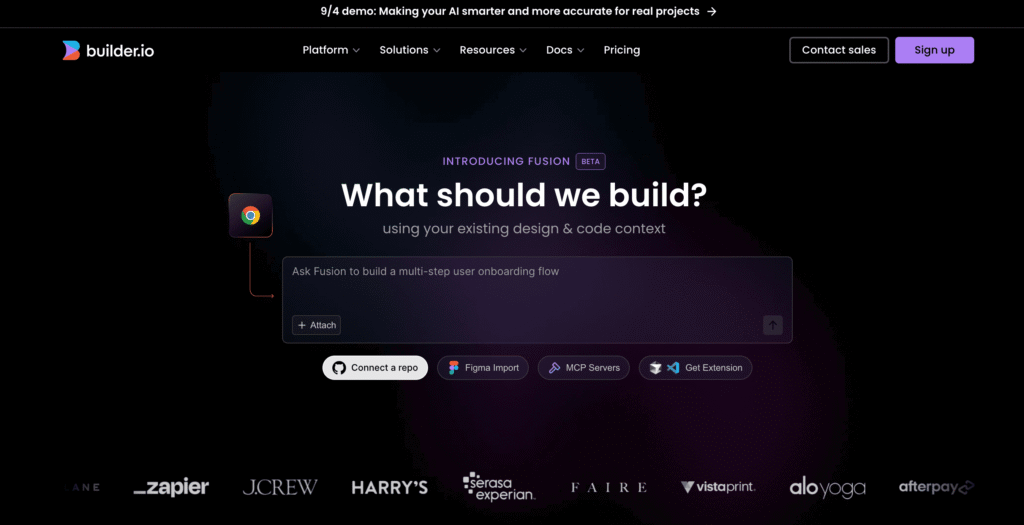
Builder.io positions itself as a visual development and content platform, designed to bridge the gap between marketing teams and developers.
It provides powerful drag-and-drop editing on top of a headless architecture, with particular strength in e-commerce and experimentation.
Unlike many headless CMSs, Builder.io emphasizes not just content delivery but alsoA/B testing, personalization, and performance optimization.
Best For
- Marketing and e-commerce teams that need to iterate quickly without developer bottlenecks
- Organizations looking for a CMS that supports experimentation and personalization out of the box
- Teams that want visual editing and analytics alongside API-driven content delivery
Standout Features
- Visual Editor: A true no-code environment where marketers can drag-and-drop content, update pages, and launch campaigns without developer intervention.
- Experimentation & Personalization: Built-in A/B testing, targeting, and analytics integrations to optimize digital experiences.
- Composable Content Hub: API-first architecture ensures content can be delivered anywhere, not just web storefronts.
- Integrations with Frontend Frameworks: Strong support for Next.js, React, and e-commerce platforms like Shopify and BigCommerce.
- Performance Optimization: Features like image optimization, edge delivery, and SDKs for modern frameworks.
Recent Developments
- Expanded visual experimentation tools in 2024–2025, strengthening its appeal for e-commerce and growth teams.
- Enhanced integrations with leading commerce and analytics platforms, making Builder.io a strong contender in the composable commerce ecosystem.
- Focused on improving developer experience, ensuring teams can extend the platform with custom components and APIs.
Considerations
- Best suited for teams that will use the experimentation and personalization layer; otherwise, some features may feel like overkill.
- SaaS model with premium capabilities tied to usage and experimentation volume can raise costs at scale.
3. Prismic – Slice-Based Page Building
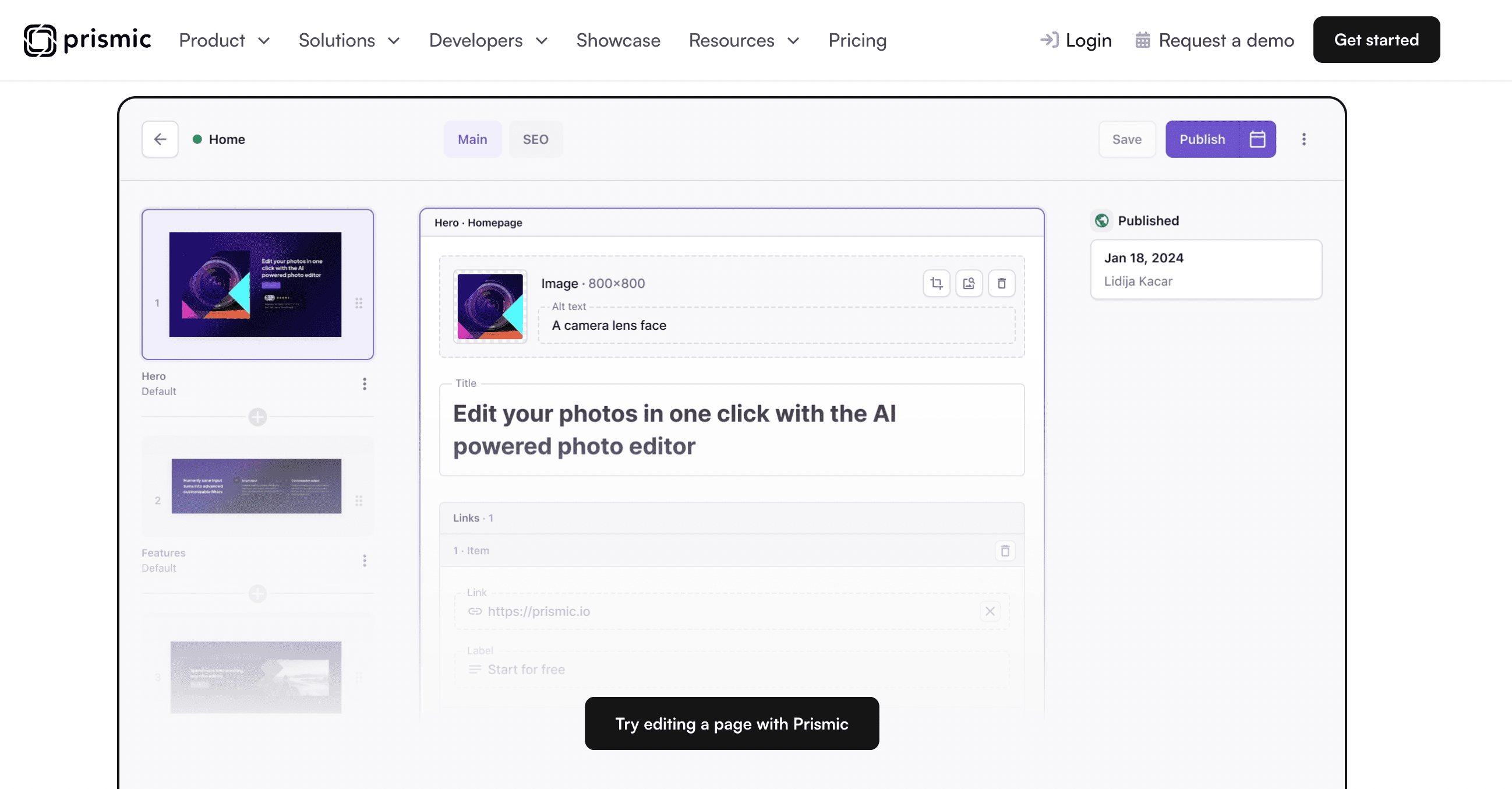
Prismic is a headless CMS with a strong focus on simplicity and editorial freedom, best known for its unique “Slice” approach.
Instead of rigid templates, developers create reusable “Slices” (content blocks), which marketers can then assemble into pages.
This makes Prismic particularly appealing to teams who want a balance of design consistency and editorial flexibility.
Best For
- Content and marketing teams who want to compose pages quickly without relying heavily on developers
- Design-conscious organizations seeking consistent branding across sites
- Companies looking for a straightforward, editor-friendly SaaS CMS with predictable pricing
Standout Features
- Slice Machine: Developers define content components (“Slices”); editors use them to build pages visually with drag-and-drop flexibility.
- Visual Page Builder: Marketers can preview and publish updates with minimal technical support.
- Multi-Channel Delivery: Content is API-first, making it usable beyond websites.
- Integration Ecosystem: Plugins and SDKs for frameworks like Next.js, Nuxt, and React.
- Developer Workflow Support: Git-based versioning and command-line tools for developer setup.
Recent Developments
- Continued investment in Slice Machine, adding tighter integration with design and development workflows.
- Improved preview environments and editor UX in 2024–2025, making it easier for marketers to see changes before publishing.
- Expanded integration options for popular frontend frameworks and commerce solutions.
Considerations
- Lighter on enterprise governance features compared to Storyblok or Contentful.
- Best suited for small-to-mid-sized teams; enterprises may find its feature depth limiting for complex global use cases.
GraphQL-First Headless CMS Platforms
1. Hygraph – GraphQL-Native with Content Federation
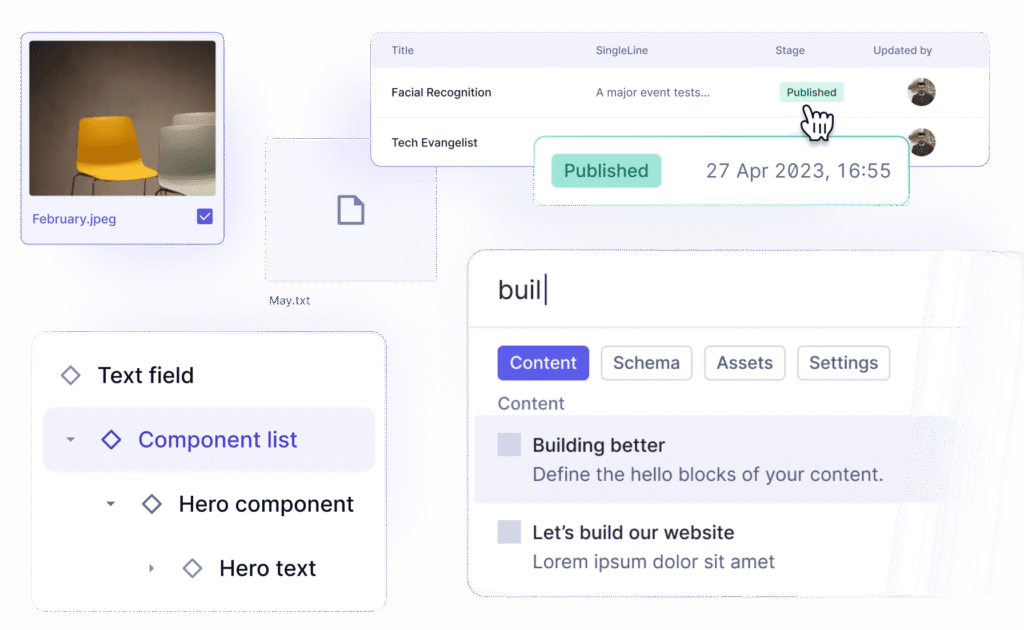
Hygraph is a GraphQL-native headless CMS designed for teams that need to unify and distribute content across multiple digital products.
Its standout feature is Content Federation, which allows organizations to pull data from external sources (commerce, PIM, DAM, etc.) and serve it through a single GraphQL API.
This makes Hygraph a strong choice for companies managing complex, multi-source content ecosystems.
Best For
- Organizations that want a single GraphQL API for all content and related data
- Teams with multiple backend systems (e.g., commerce, DAM, CRM) that need to be unified
- Developer-heavy organizations that value GraphQL performance and flexibility
Standout Features
- Content Federation: Connects external APIs and services, merging them into a unified GraphQL schema.
- GraphQL API-first: Every piece of content is accessible via GraphQL, with powerful filtering, relations, and real-time queries.
- Editor-Friendly UI: Structured content creation with workflows and localization support.
- Enterprise Features: Role-based access control, SSO, and audit logs for governance.
- Marketplace: Integrations for commerce, search, DAM, and analytics.
Recent Developments
- Expanded Content Federation capabilities, positioning Hygraph as more than just a CMS – closer to a content integration hub.
- Continued investments in performance and caching for high-scale GraphQL delivery.
- UI improvements in 2024–2025, making the editor experience more intuitive while preserving developer flexibility.
Considerations
- Strong GraphQL focus may be overkill for smaller teams that don’t need complex integrations.
- Federation features shine in multi-system architectures; simpler use cases may find other platforms more cost-effective.
2. DatoCMS – GraphQL, Media Pipeline, Strong Authoring
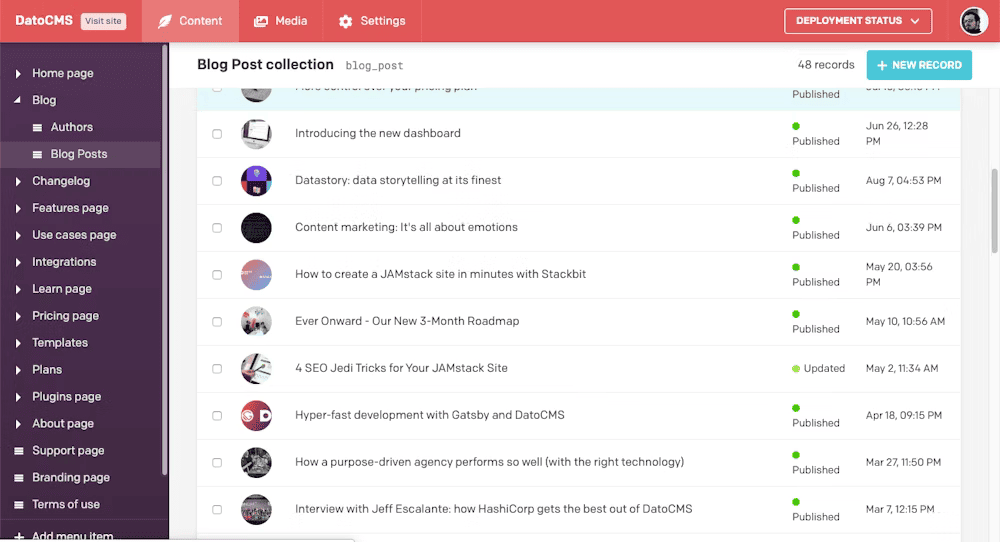
DatoCMS is a SaaS headless CMS with a strong emphasis on GraphQL delivery, performance, and localization.
Known for its developer-friendly APIs and polished editor experience, it’s a favorite among teams that want fast, global content delivery paired with a clean authoring interface.
Its built-in CDN and media pipeline make it particularly appealing for organizations prioritizing performance.
Best For
- Teams that want a fast, reliable GraphQL API without heavy developer setup
- Organizations managing multi-language content at scale
- Businesses that value a strong balance between developer tooling and editor usability
Standout Features
- First-Class GraphQL: Flexible queries with advanced filtering, relations, and real-time updates.
- Global CDN Delivery: Built-in edge caching for content and assets.
- Media Pipeline: Image and video optimization, transformations, and responsive delivery.
- Editor-Friendly UI: Clean interface, inline editing, and workflows that balance structure with ease of use.
- Localization Tools: Advanced support for multi-language content management.
Recent Developments
- Expanded media handling capabilities, including video delivery pipelines and edge optimizations.
- Continuous improvements to the editor UI for a smoother non-technical user experience.
- Enhancements to GraphQL performance and API limits, making it suitable for enterprise-scale projects.
Considerations
- SaaS pricing scales with usage (records, API calls, locales), which can add up for large enterprises.
- Less extensible than open-source options like Strapi or Payload, as customization depends on vendor roadmap.
- Smaller ecosystem compared to Contentful or Contentstack, though integrations cover most common needs.
Developer-Led / Self-Hosted Healdess CMS
1. Strapi 5 – Open-Source, Self-Hosted Control
Snapshot
Strapi is the most popular open-source headless CMS, giving development teams full control over hosting, customization, and extensibility.
With the release of Strapi v5 (September 2024), the platform has doubled down on TypeScript, plugin architecture, and enterprise-readiness, making it a strong choice for organizations that value ownership and flexibility over SaaS convenience.
Best For
- Development teams that want full control over their CMS (self-hosted or cloud)
- Organizations with strong engineering resources that prefer open-source software
- Businesses that need custom APIs, plugins, or integration-heavy workflows
Standout Features
- Open-Source & Self-Hosted: Complete freedom to run on your own infrastructure, or use Strapi Cloud for managed hosting.
- API-First Architecture: REST and GraphQL APIs generated automatically from content models.
- Plugin Ecosystem & SDK: Developers can build or install plugins to extend functionality (authentication, workflows, DAM).
- TypeScript-Native: Strong typing support introduced in v5 improves developer productivity and stability.
- Content Preview & Versioning: New features in v5 make editorial workflows more competitive with SaaS rivals.
Recent Developments
- Strapi v5 Release (2024): Brought TypeScript support, a re-engineered plugin system, and better developer tooling.
- Expanded Strapi Cloud, offering managed hosting for teams who want convenience without losing OSS flexibility.
- Growing adoption in enterprise and agency environments as governance and workflow features mature.
Considerations
- Requires technical expertise to set up, scale, and maintain compared to turnkey SaaS solutions.
- Enterprise features (e.g., SSO, role-based workflows) are available but often require additional setup or enterprise licensing.
- Editor experience, while improving, is still more developer-centric than platforms like Storyblok or Builder.io.
2. Payload – Next.js-Native, Code-First Control
Payload is a developer-first, self-hosted headless CMS built in Node.js and TypeScript, with a deep focus on extensibility and performance.
It integrates seamlessly with modern frameworks (especially Next.js) and gives teams complete ownership of their code and infrastructure.
Its strong access control, file management, and code-first approach make it particularly appealing to engineering-driven organizations.
Best For
- Engineering teams that want full-stack control over their CMS and hosting
- Projects built with Next.js, React, or TypeScript
- Organizations prioritizing granular access control and custom backend logic
Standout Features
- Code-First Content Modeling: Content types are defined directly in code, allowing versioning and tight integration with developer workflows.
- Advanced Access Control: Fine-grained rules can be written in JavaScript/TypeScript for complex permissions.
- Next.js Native Support: Built to pair with modern frameworks, with starter kits and deep integration.
- Media & File Handling: Robust file upload, image resizing, and storage integrations.
- GraphQL and REST APIs: Auto-generated from content models, flexible for various delivery needs.
Recent Developments
- Payload v3 (2025): Major release focused on performance, scalability, and expanded cloud support.
- Introduced improvements to the admin UI for a more polished editorial experience.
- Enhanced cloud deployment options, making Payload more accessible for teams who don’t want to self-manage hosting.
Considerations
- Best suited for developer-led teams; marketers may find the editorial tools less intuitive than visual-first SaaS options.
- Requires hosting and DevOps setup, unless using Payload Cloud.
- While rapidly growing, the ecosystem and marketplace are smaller compared to open-source incumbents like Strapi.
3. Directus – Database-First Headless / Data Platform
Directus is a database-first headless CMS and data platform that layers an API and a no-code admin app on top of any SQL database.
Unlike most headless CMS platforms, which store content in their own structures, Directus connects directly to your database schema, instantly generating REST and GraphQL APIs along with a sleek admin UI.
This makes it especially appealing for data-heavy applications where the CMS needs to sit alongside existing systems.
Best For
- Engineering teams with existing SQL databases that want a CMS without migrating data
- Organizations building custom applications or dashboards that need content + data management
- Teams that value flexibility in data modeling beyond traditional CMS structures
Standout Features
- Database-First Approach: Connects to MySQL, Postgres, SQLite, and others – no need to change your existing schema.
- Automatic APIs: Instantly generates REST and GraphQL APIs from your database.
- No-Code Admin App: Provides an elegant UI for non-technical users to manage data and content.
- Extensibility: Modular architecture with hooks, extensions, and custom endpoints.
- Open Source & Self-Hosted: Run anywhere, or use Directus Cloud for managed hosting.
Recent Developments
- Continuous investment in Directus 10, with improvements to UX, role-based access, and performance.
- Expanded extension framework, making it easier for developers to customize and add features.
- Growing traction as both a CMS and a general-purpose data management layer for bespoke applications.
Considerations
- Best suited for projects that already rely heavily on relational data models.
- Strongest fit for developer-led teams; marketing users may find the editing experience less polished than Storyblok or Builder.io.
- Requires hosting and database management unless using Directus Cloud.
4. Sanity – Schema-as-Code with AI Assist
Sanity is a schema-as-code headless CMS with a strong reputation among developers for its flexibility and extensibility.
At its core is the Sanity Studio, a highly customizable React-based editing environment that can be tailored to fit unique workflows.
Sanity also offers the Content Lake, a real-time, queryable datastore that ensures content is instantly available across channels.
With the addition of AI Assist, Sanity has been expanding its usability for non-technical teams while keeping its developer-first ethos.
Best For
- Developer-heavy teams that want schema-as-code flexibility
- Organizations looking for a CMS that can be heavily customized to fit workflows
- Teams that want a balance of powerful APIs and editor-focused features
Standout Features
- Sanity Studio: A React-based, open-source editor that teams can extend or customize as needed.
- Content Lake: Real-time, cloud-hosted datastore that makes content instantly queryable.
- AI Assist: Helps with content authoring, localization, and structuring directly inside the Studio.
- Portable Text: Structured content format designed to keep content reusable across channels.
- Rich Integrations: Works well with frameworks like Next.js, and connects into commerce, DAM, and analytics systems.
Recent Developments
- 2024–2025: Ongoing enhancements to the Sanity Studio, including new Canvas/Dashboard features for improved editorial workflows.
- Expanded AI Assist, making content creation and editing faster and more accessible for non-technical users.
- Continued investment in performance and federation-like integrations through Sanity Connectors.
Considerations
- Requires developer setup and maintenance for custom Studio configurations.
- Editor experience is powerful but less turnkey compared to visual-first CMS platforms like Storyblok or Builder.io.
- Pricing can scale quickly with API usage, environments, and seats.
5. Decap CMS – Git-Based and Free
Decap CMS is a lightweight, open-source Git-based headless CMS designed for simplicity.
Instead of running as a separate database-driven system, it stores content directly in a Git repository, making it an ideal companion for static site generators (e.g., Gatsby, Hugo, Jekyll).
As a result, it appeals to developers and small teams who want version-controlled content without the complexity of a traditional CMS.
Best For
- Small teams, startups, or individuals looking for a free, lightweight CMS
- Developers building static sites or JAMstack projects
- Projects where content lives comfortably in Markdown, JSON, or YAML files within Git
Standout Features
- Git-Based Workflow: Content changes are stored as commits in your repository, providing full version control.
- Markdown/Flat-File Storage: Simple content storage that works well with static site generators.
- No Database Required: Content is served directly from Git, reducing infrastructure complexity.
- Open Source: Free to use, extend, and self-host.
- Decap Community Plugins: Basic ecosystem for extending functionality.
Recent Developments
- Rebranded from Netlify CMS to Decap CMS, affirming independence from Netlify while retaining JAMstack alignment.
- Continued improvements in editor UI, localization support, and deployment flexibility.
- Growing support for Decap Cloud deployments and community-driven enhancements.
Considerations
- Lacks the advanced features (AI, federation, visual editing) found in enterprise SaaS platforms.
- Editorial experience is minimalist; non-technical marketers may find it less user-friendly compared to Storyblok or Builder.io.
How to Evaluate a Headless CMS
A good way to narrow the choice down is to focus on a few key criteria:
- Editing experience (UX): Does the platform make it easy for content editors and marketers to create, preview, and publish content without leaning too heavily on developers?
- Performance & delivery: Look at how the CMS handles speed – does it include CDN delivery, media optimization, or edge support for personalization?
- AI capabilities: Many platforms now use AI to help with content creation, localization, and even structuring. Consider whether your team would benefit from those tools.
- Composability: Think about how the CMS fits into the bigger picture. Will it integrate easily with your commerce, analytics, DAM, or personalization systems? Is it flexible enough to evolve as your tech stack grows?
By weighing each platform against these factors, you can quickly separate the ones that simply “manage content” from those that will actually accelerate your digital strategy.
Implementation Playbook: How to Adopt a Headless CMS in 2025
Shifting to a headless CMS is an architectural and operational change. Here’s a practical roadmap for making the transition smoothly.
1. Define Goals and Use Cases
- Clarify why you’re moving: speed, omnichannel delivery, governance, personalization, or developer freedom.
- Identify your “must-have” features (e.g., visual editing for marketers vs. API federation for developers).
- Map use cases across all channels: website, app, digital signage, voice, etc.
2. Choose the Right Modeling Approach
- Component-based (Slices, Blocks): Flexible for editors, great for marketing sites (e.g., Storyblok, Prismic, Builder.io).
- Schema-as-code: Highly customizable and version-controlled (e.g., Sanity, Payload).
- Database-first: Ideal for data-heavy systems (e.g., Directus).
3. Plan Editorial Workflows & Governance
- Define roles, permissions, and approval chains early.
- Set up localization workflows if working across multiple regions/languages.
- Decide on versioning and preview environments to support safe publishing.
4. Architect Your Composable Stack
- Decide if CMS will be paired with a DXP layer (e.g., Contentstack EDGE, Contentful + personalization, Hygraph federation).
- Integrate supporting systems (e-commerce, DAM, CRM, analytics, search).
- Ensure APIs can scale across all digital touchpoints.
5. Prioritize Performance & Delivery
- Use built-in CDN and media pipelines (DatoCMS, Contentful, Storyblok) or plan third-party delivery.
- Ensure support for edge delivery for real-time personalization.
- Test Core Web Vitals and load speeds early in pilot builds.
6. Prepare a Migration Plan
- Inventory current content: audit what to migrate, what to archive.
- Map old content models to new schemas.
- Run parallel content delivery (old + new CMS) before cutover.
- Don’t forget redirects and SEO continuity.
7. Assess Total Cost of Ownership
- Budget for licensing, API usage, and user seats (SaaS).
- Factor in DevOps, hosting, and maintenance (self-hosted/OSS).
- Account for agency/partner costs if external implementation support is needed.
8. Train & Enable Teams
- Provide training sessions for editors, developers, and product owners.
- Document workflows and publishing guidelines.
- Encourage cross-team collaboration between marketing and engineering.
Conclusion
The world of headless CMS in 2025 is packed with great options. What used to be a niche tool for developers has grown into a full marketplace of platforms that balance flexibility, speed, and ease of use.
Here’s the quick recap:
- Big enterprises → Contentstack, Contentful, Kontent.ai
- Marketing teams who want visual editing → Storyblok, Builder.io, Prismic
- Developer-led teams → Strapi 5, Payload, Directus, Sanity
- GraphQL fans → Hygraph, DatoCMS
- Small projects or side hustles → Decap CMS
At the end of the day, the best CMS is the one that fits your team: how you work, how technical you are, and where you want your content to go.
The good news? All of these platforms give you a headless foundation that’s ready for the future – whether that’s a website, mobile app, or a channel we haven’t even thought of yet.

